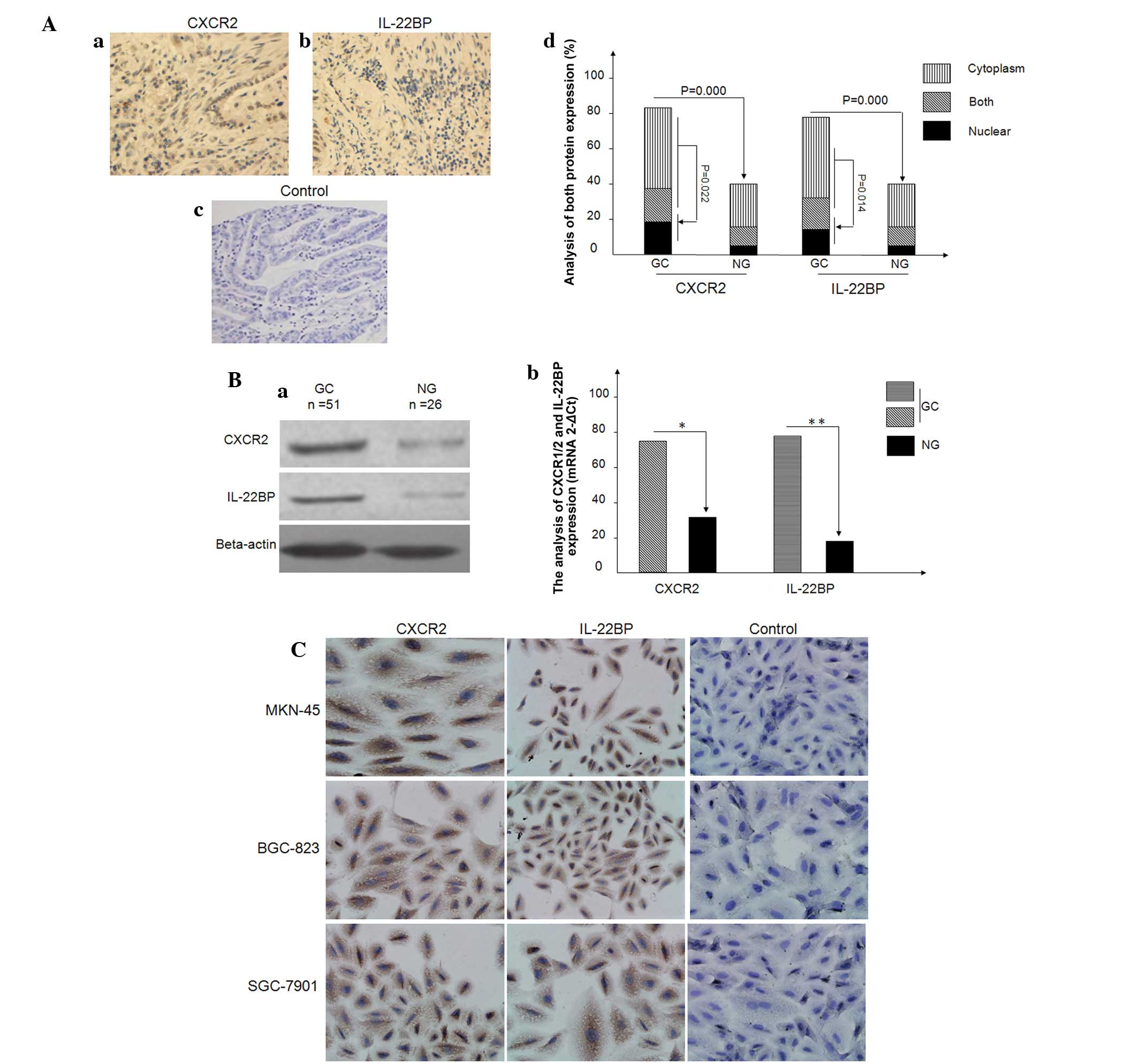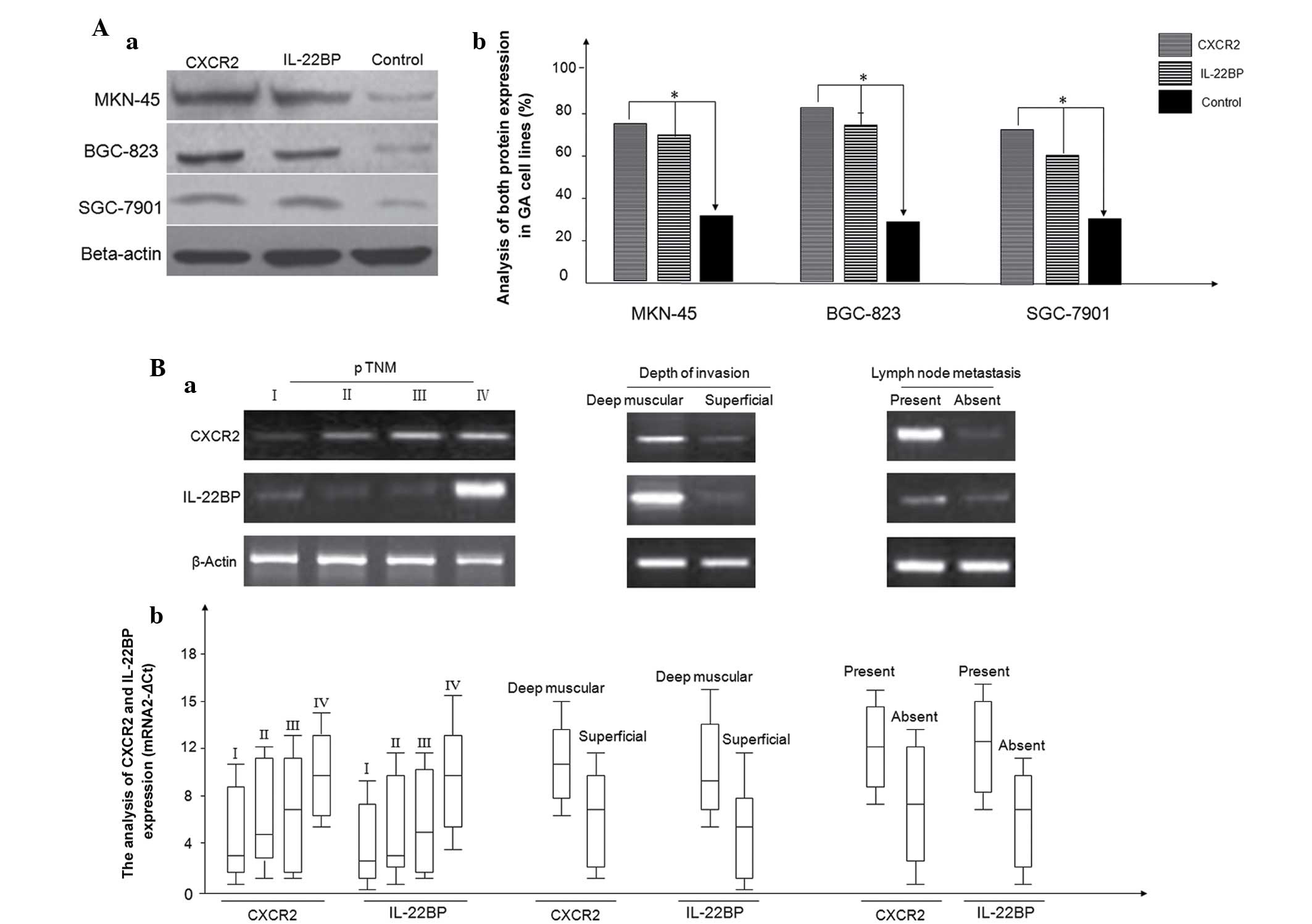|
1
|
Jemal A, Siegel R, Ward E, Hao Y, Xu J,
Murray T and Thun MJ: Cancer statistics, 2008. CA Cancer J Clin.
58:71–96. 2008. View Article : Google Scholar : PubMed/NCBI
|
|
2
|
Wang CS, Hsieh CC, Chao TC, Jan YY, Jeng
LB, Hwang TL, Chen MF, Chen PC, Chen JS and Hsueh S: Resectable
gastric cancer: Operative mortality and survival analysis. Chang
Gung Med J. 25:216–227. 2002.PubMed/NCBI
|
|
3
|
Bernal C, Aguayo F, Villarroel C, Vargas
M, Díaz I, Ossandon FJ, Santibáñez E, Palma M, Aravena E,
Barrientos C and Corvalan AH: Reprimo as a potential biomarker for
early detection in gastric cancer. Clin Cancer Res. 14:6264–6269.
2008. View Article : Google Scholar : PubMed/NCBI
|
|
4
|
Marrelli D, Roviello F, De Stefano A,
Farnetani M, Garosi L, Messano A and Pinto E: Prognostic
significance of CEA, CA 19-9 and CA 72-4 preoperative serum levels
in gastric carcinoma. Oncology. 57:55–62. 1999. View Article : Google Scholar : PubMed/NCBI
|
|
5
|
DeNardo DG, Barreto JB, Andreu P, Vasquez
L, Tawfik D, Kolhatkar N and Coussens LM: CD4 (+) T cells regulate
pulmonary metastasis of mammary carcinomas by enhancing protumor
properties of macrophages. Cancer Cell. 16:91–102. 2009. View Article : Google Scholar : PubMed/NCBI
|
|
6
|
Ikushima H and Miyazono K: TGFbeta
signalling: A complex web in cancer progression. Nat Rev Cancer.
10:415–424. 2010. View
Article : Google Scholar : PubMed/NCBI
|
|
7
|
Balkwill F, Charles KA and Mantovani A:
Smoldering and polarized inflammation in the initiation and
promotion of malignant disease. Cancer Cell. 7:211–217. 2005.
View Article : Google Scholar : PubMed/NCBI
|
|
8
|
Cheng WL, Wang CS, Huang YH, Tsai MM,
Liang Y and Lin KH: Overexpression of CXCL1 and its receptor CXCR2
promote tumor invasion in gastric cancer. Ann Oncol. 22:2267–2276.
2010. View Article : Google Scholar
|
|
9
|
Wang CS, Lin KH, Chen SL, Chan YF and
Hsueh S: Overexpression of SPARC gene in human gastric carcinoma
and its clinic-pathologic significance. Br J Cancer. 91:1924–1930.
2004. View Article : Google Scholar : PubMed/NCBI
|
|
10
|
Wang D, Yang W, Du J, Devalaraja MN, Liang
P, Matsumoto K, Tsubakimoto K, Endo T and Richmond A:
MGSA/GRO-mediated melanocyte transformation involves induction of
Ras expression. Oncogene. 19:4647–4659. 2000. View Article : Google Scholar : PubMed/NCBI
|
|
11
|
Murphy PM: The molecular biology of
leukocyte chemoattractant receptors. Annu Rev Immunol. 12:593–633.
1994. View Article : Google Scholar : PubMed/NCBI
|
|
12
|
Kelvin DJ, Michiel DF, Johnston JA, Lloyd
AR, Sprenger H, Oppenheim JJ and Wang JM: Chemokines and
serpentines: The molecular biology of chemokine receptors. J Leukoc
Biol. 54:604–612. 1993.PubMed/NCBI
|
|
13
|
Ahuja SK and Murphy PM: The CXC chemokines
growth-regulated oncogene (GRO) alpha, GRObeta, GROgamma,
neutrophil-activating peptide-2 and epithelial cell-derived
neutrophil-activating peptide-78 are potent agonists for the type
B, but not the type A, human interleukin-8 receptor. J Biol Chem.
271:20545–20550. 1996. View Article : Google Scholar : PubMed/NCBI
|
|
14
|
Ahuja SK, Lee JC and Murphy PM: CXC
chemokines bind to unique sets of selectivity determinants that can
function independently and are broadly distributed on multiple
domains of human interleukin-8 receptor B. Determinants of high
affinity binding and receptor activation are distinct. J Biol Chem.
271:225–232. 1996. View Article : Google Scholar : PubMed/NCBI
|
|
15
|
Fan X, Patera AC, Pong-Kennedy A, Deno G,
Gonsiorek W, Manfra DJ, Vassileva G, Zeng M, Jackson C, Sullivan L,
et al: Murine CXCR1 is a functional receptor for GCP-2/CXCL6 and
interleukin-8/CXCL8. J Biol Chem. 282:11658–11666. 2007. View Article : Google Scholar : PubMed/NCBI
|
|
16
|
Tazawa H, Okada F, Kobayashi T, Tada M,
Mori Y, Une Y, Sendo F, Kobayashi M and Hosokawa M: Infiltration of
neutrophils is required for acquisition of metastatic phenotype of
benign murine fibrosarcoma cells: Implication of
inflammation-associated carcinogenesis and tumor progression. Am J
Pathol. 163:2221–2232. 2003. View Article : Google Scholar : PubMed/NCBI
|
|
17
|
Brand S, Beigel F, Olszak T, Zitzmann K,
Eichhorst ST, Otte JM, Diepolder H, Marquardt A, Jagla W, Popp A,
et al: IL-22 is increased in active Crohn's disease and promotes
proinflammatory gene expression and intestinal epithelial cell
migration. Am J Physiol Gastrointest Liver Physiol. 290:G827–G838.
2006. View Article : Google Scholar : PubMed/NCBI
|
|
18
|
Wolk K, Witte E, Hoffmann U, Doecke WD,
Endesfelder S, Asadullah K, Sterry W, Volk HD, Wittig BM and Sabat
R: IL-22 induces lipopolysaccharide-binding protein in hepatocytes:
A potential systemic role of IL-22 in Crohn's disease. J Immunol.
178:5973–5981. 2007. View Article : Google Scholar : PubMed/NCBI
|
|
19
|
Xu W, Presnell SR, Parrish-Novak J,
Kindsvogel W, Jaspers S, Chen Z, Dillon SR, Gao Z, Gilbert T,
Madden K, et al: A soluble class II cytokine receptor, IL-22RA2, is
a naturally occurring IL-22 antagonist. Proc Natl Acad Sci USA.
98:9511–9516. 2001. View Article : Google Scholar : PubMed/NCBI
|
|
20
|
Witte E, Witte K, Warszawska K, Sabat R
and Wolk K: Interleukin-22: A cytokine produced by T, NK and NKT
cell subsets, with importance in the innate immune defense and
tissue protection. Cytokine Growth Factor Rev. 21:365–379. 2010.
View Article : Google Scholar : PubMed/NCBI
|
|
21
|
Sonnenberg GF, Fouser LA and Artis D:
Border patrol: Regulation of immunity, inflammation and tissue
homeostasis at barrier surfaces by IL-22. Nat Immunol. 12:383–390.
2011. View
Article : Google Scholar : PubMed/NCBI
|
|
22
|
Huber S, Gagliani N, Zenewicz LA, Huber
FJ, Bosurgi L, Hu B, Hedl M, Zhang W, O'Connor W Jr, Murphy AJ, et
al: IL-22BP is regulated by the inflammasome and modulates
tumorigenesis in the intestine. Nature. 491:259–263. 2012.
View Article : Google Scholar : PubMed/NCBI
|
|
23
|
Zenewicz LA, Yancopoulos GD, Valenzuela
DM, Murphy AJ, Stevens S and Flavell RA: Innate and adaptive
interleukin-22 protects mice from inflammatory bowel disease.
Immunity. 29:947–957. 2008. View Article : Google Scholar : PubMed/NCBI
|
|
24
|
Zurleni T, Gjoni E, Ballabio A, Casieri R,
Ceriani P, Marzoli L and Zurleni F: Sixth and seventh
tumor-node-metastasis staging system compared in gastric cancer
patients. World J Gastrointest Surg. 5:287–293. 2013. View Article : Google Scholar : PubMed/NCBI
|
|
25
|
Hsu SM, Raine L and Fanger H: The use of
antiavidin antibody and avidin-biotin-peroxidase complex in
immunoperoxidase technics. Am J Clin Pathol. 75:816–821. 1981.
View Article : Google Scholar : PubMed/NCBI
|
|
26
|
Hsu SM, Raine L and Fanger H: Use of
avidin-biotin-peroxidase complex (ABC) in immunoperoxidase
techniques: A comparison between ABC and unlabeled antibody (PAP)
procedures. J Histochem Cytochem. 29:577–580. 1981. View Article : Google Scholar : PubMed/NCBI
|
|
27
|
Harvey JM, Clark GM, Osborne CK and Allred
DC: Estrogen receptor status by immunohistochemistry is superior to
the ligand-binding assay for predicting response to adjuvant
endocrine therapy in breast cancer. J Clin Oncol. 17:1474–1481.
1999.PubMed/NCBI
|
|
28
|
Lazennec G and Richmond A: Chemokines and
chemokine receptors: New insights into cancer-related inflammation.
Trends Mol Med. 16:133–144. 2010. View Article : Google Scholar : PubMed/NCBI
|
|
29
|
Washington K: 7th edition of the AJCC
cancer staging manual: Stomach. Ann Surg Oncol. 17:3077–3079. 2010.
View Article : Google Scholar : PubMed/NCBI
|
|
30
|
Heidemann J, Ogawa H, Dwinell MB, Rafiee
P, Maaser C, Gockel HR, Otterson MF, Ota DM, Lugering N, Domschke W
and Binion DG: Angiogenic effects of interleukin 8 (CXCL8) in human
intestinal microvascular endothelial cells are mediated by CXCR2. J
Biol Chem. 278:8508–8515. 2003. View Article : Google Scholar : PubMed/NCBI
|
|
31
|
Mestas J, Burdick MD, Reckamp K, Pantuck
A, Figlin RA and Strieter RM: The role of CXCR2/CXCR2 ligand
biological axis in renal cell carcinoma. J Immunol. 175:5351–5357.
2005. View Article : Google Scholar : PubMed/NCBI
|
|
32
|
Yang G, Rosen DG, Zhang Z, Bast RC Jr,
Mills GB, Colacino JA, Mercado-Uribe I and Liu J: The chemokine
growth-regulated oncogene 1 (Gro-1) links RAS signaling to the
senescence of stromal fibroblasts and ovarian tumorigenesis. Proc
Natl Acad Sci USA. 103:16472–16477. 2006. View Article : Google Scholar : PubMed/NCBI
|
|
33
|
Tekamp-Olson P, Gallegos C, Bauer D,
McClain J, Sherry B, Fabre M, van Deventer S and Cerami A: Cloning
and characterization of cDNAs for murine macrophage inflammatory
protein 2 and its human homologues. J Exp Med. 172:911–919. 1990.
View Article : Google Scholar : PubMed/NCBI
|
|
34
|
Bozic CR, Kolakowski LF Jr, Gerard NP,
Garcia-Rodriguez C, von Uexkull-Guldenband C, Conklyn MJ, Breslow
R, Showell HJ and Gerard C: Expression and biologic
characterization of the murine chemokine KC. J Immunol.
154:6048–6057. 1995.PubMed/NCBI
|
|
35
|
Harada A, Kuno K, Nomura H, Mukaida N,
Murakami S and Matsushima K: Cloning of a cDNA encoding a mouse
homolog of the interleukin-8 receptor. Gene. 142:297–300. 1994.
View Article : Google Scholar : PubMed/NCBI
|
|
36
|
Martin JC, Bériou G, Heslan M, Chauvin C,
Utriainen L, Aumeunier A, Scott CL, Mowat A, Cerovic V, Houston SA,
et al: Interleukin-22 binding protein (IL-22BP) is constitutively
expressed by a subset of conventional dendritic cells and is
strongly induced by retinoic acid. Mucosal Immunol. 7:101–113.
2014. View Article : Google Scholar : PubMed/NCBI
|
|
37
|
Dumoutier L, Lejeune D, Colau D and
Renauld JC: Cloning and characterization of IL-22 binding protein,
a natural antagonist of IL-10-related T cell-derived inducible
factor/IL-22. J Immunol. 166:7090–7095. 2001. View Article : Google Scholar : PubMed/NCBI
|

















